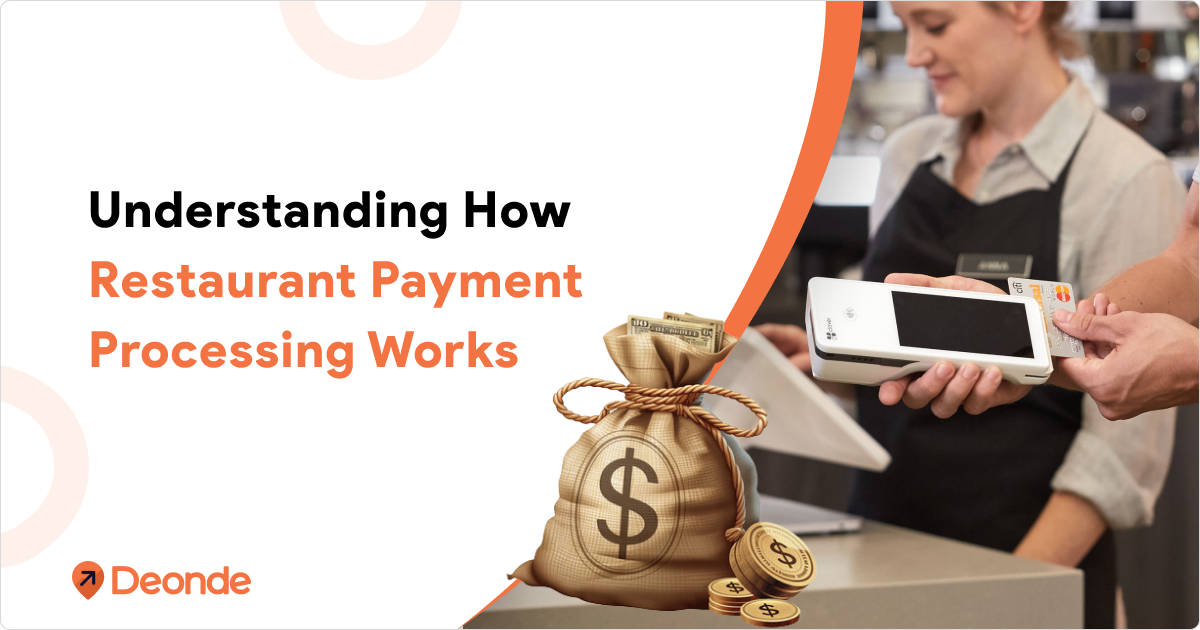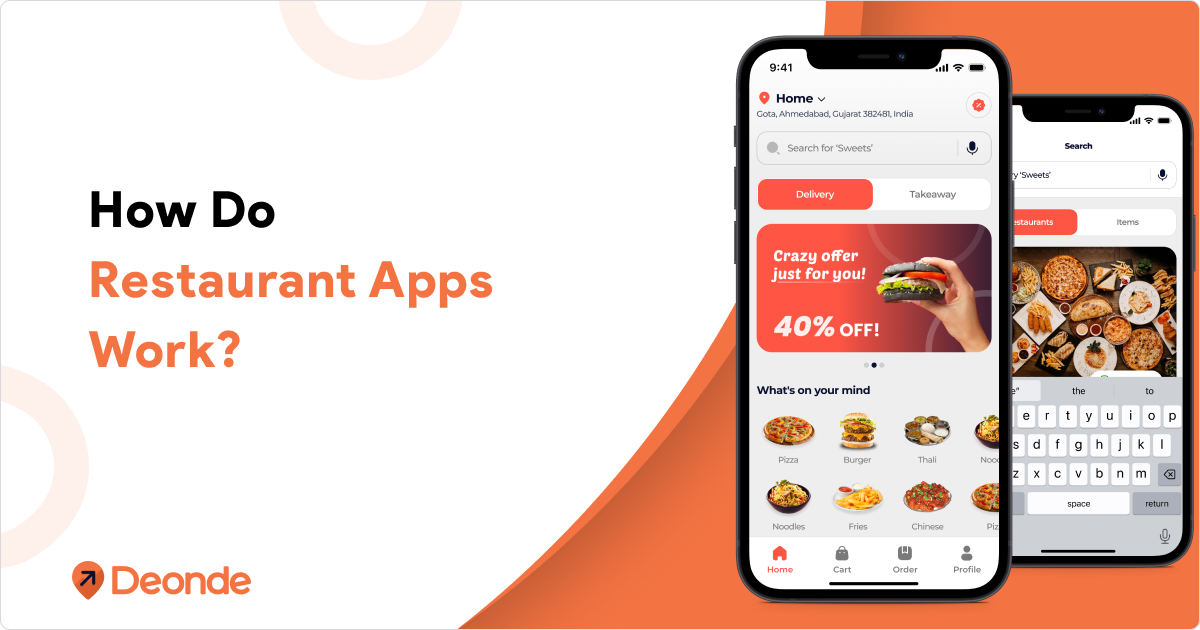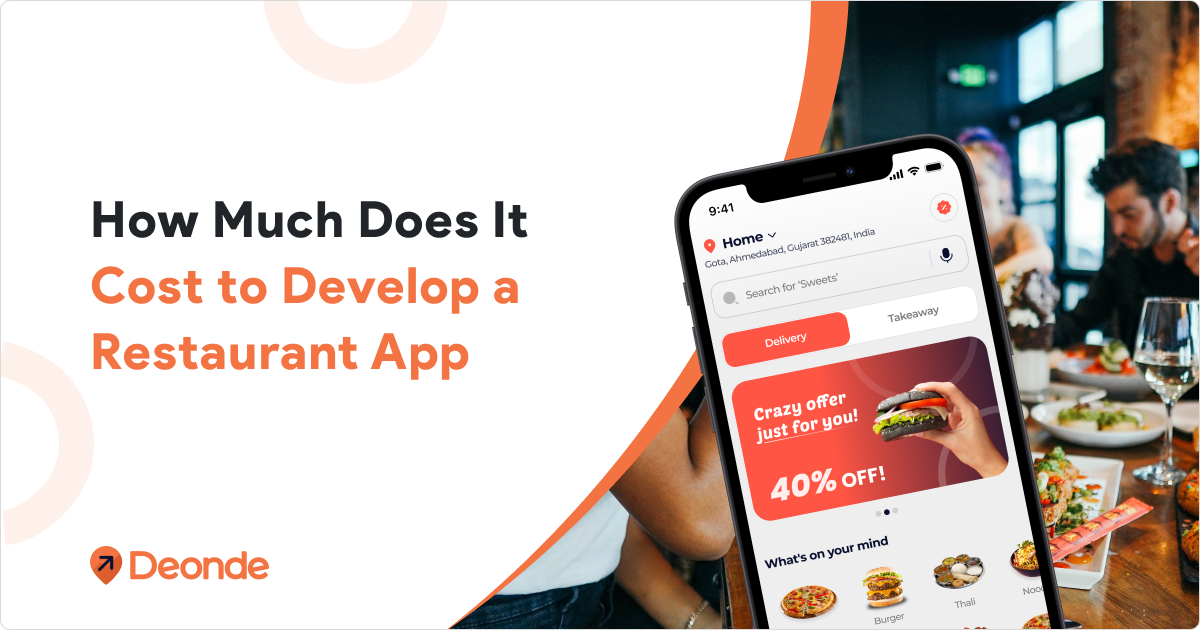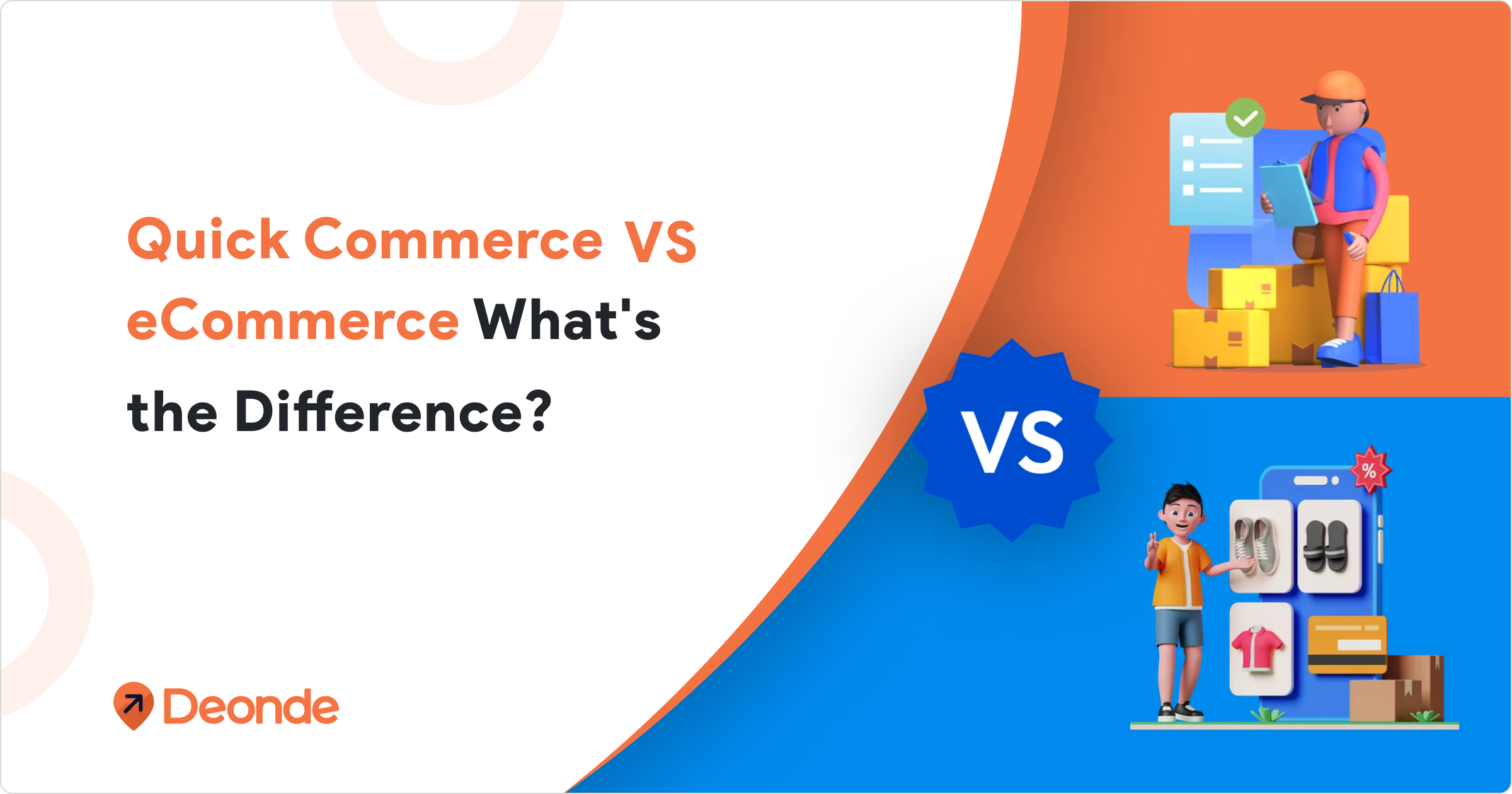The food delivery and service industry has never been this competitive. Hence, installing an efficient and secure payment processing system isn’t just a convenience—it’s a necessity.
Research shows that seven out of every ten diners prefer paying digitally.
Hence, restaurant owners must adapt to this growing preference and integrate multiple secure and compliant online payment options.
A well-optimized payment processing system enhances customer experience, keeps overheads low, and streamlines operations.
This blog is for restaurant owners who want to offer payment options that seamlessly align with their customers’ needs.
Read along as we break down how restaurant payment processing works and the key features to look for in a secure payment processing system.
What is a Payment Processor?
To accept payment via various modes, you need to partner with a payment processor—also known as an acquirer.
These companies provide a payment terminal, which is essentially the hardware, that enables you to accept payment through different payment methods.
These online payment systems act as the middleman between the diner, the restaurant, the credit card network (e.g., Visa or MasterCard), and the issuing bank.
Additionally, a payment processor also ensures that transactions are cleared, routed, and securely deposited into your restaurant’s account.
In return for these services, restaurant payment processors charge a transaction fee.
The rates vary depending on the type of provider you choose and are usually charged per transaction. Some processors may also include a fixed fee per transaction.
How does Payment Processing Work?
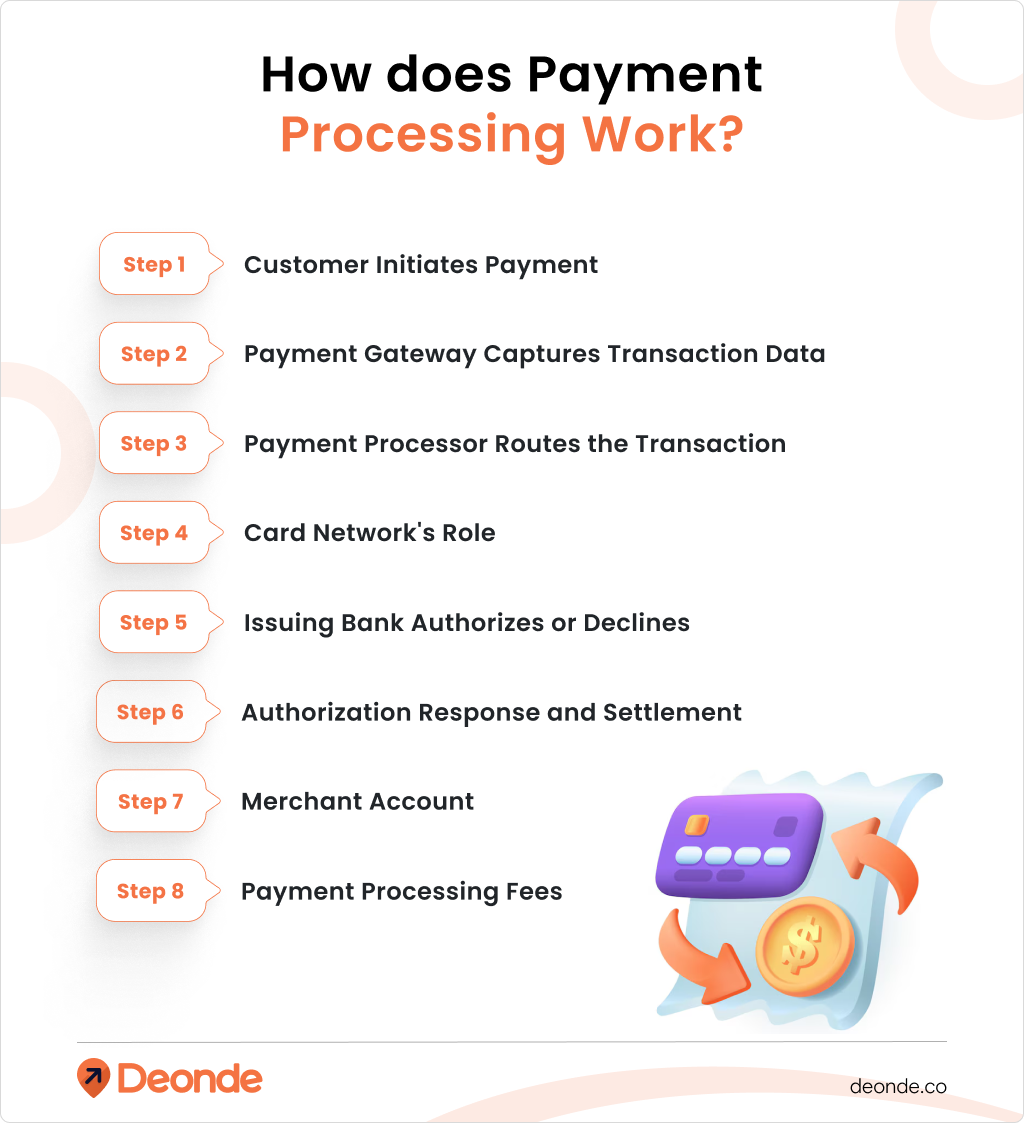
A restaurant payment processing system is a complex but efficient system involving multiple players.
It ensures secure and reliable transactions, enabling restaurants to accept various forms of electronic payments from their customers.
Each step, from the customer initiating the payment to the funds settling in the restaurant’s account, is crucial for the smooth operation of the payment ecosystem.
Here’s a breakdown of how it works:
1. The Customer Initiates Payment:
In-Person Payment:
The customer presents their credit or debit card to the restaurant staff. The staff member swipes, inserts, or taps the card on the Point of Sale (POS) terminal.
Increasingly, mobile wallets like Apple Pay or Google Pay are used, which employ Near Field Communication (NFC) for contactless payments.
Online Payments:
The customer enters their card details like their card number, expiration date, and CVV on the restaurant’s online ordering platform or a third-party delivery app.
2. The Payment Gateway Captures Transaction Data:
The payment gateway acts as a secure online portal.
It encrypts the customer’s card details and transmits them to the payment processor. This encryption is crucial for protecting sensitive data.
3. The Payment Processor Routes the Transaction:
The payment processor acts as the intermediary between the restaurant (merchant) and the various other parties. It performs two key functions:
- Transaction Routing: The processor receives the transaction data and routes it to the appropriate card network like Visa, Mastercard, American Express, or Discover.
- Authorization Request: The processor forwards the transaction details to the issuing bank for authorization.
4. The Card Network’s Role:
The card network (e.g., Visa) acts as a conduit between the acquiring bank (the restaurant’s bank) and the issuing bank (the customer’s bank).
They manage the transaction and charge a small fee (interchange fee) for their services.
5. The Issuing Bank Authorizes or Declines:
The issuing bank verifies if the customer has sufficient funds or available credit.
It checks the card’s validity and other security parameters. If everything is in order, the bank approves the transaction and issues an authorization code.
If the customer has insufficient funds, the card is expired, or there’s another issue, the bank declines the transaction and sends a decline code. The reason for the decline is often communicated back to the restaurant.
6. Authorization Response and Settlement:
The issuing bank sends an approval message back through the card network and payment processor to the POS terminal or payment gateway, completing the customer’s purchase.
While the authorization happens quickly, the actual transfer of funds (settlement) takes place later.
Typically, at the end of the business day, the restaurant’s acquiring bank collects all the approved transactions and requests funds from the issuing banks.
The funds are then deposited into the restaurant’s merchant account (a special bank account for processing card payments).
This settlement process usually takes 1-3 business days.
7. Merchant Account:
The restaurant needs a merchant account to accept card payments.
An acquiring bank or a payment processor provides this account. It holds the funds from settled transactions before they are transferred to the restaurant’s regular business bank account.
8. Payment Processing Fees:
Several fees are associated with payment processing. We’ve broken them down for you below:
- Interchange Fees: Paid to the card networks.
- Assessment Fees: Paid to the card networks.
- Processor Fees: Paid to the payment processor for their services.
- Merchant Account Fees: Fees associated with maintaining the merchant account.
Key Features of a Restaurant Payment Processing System
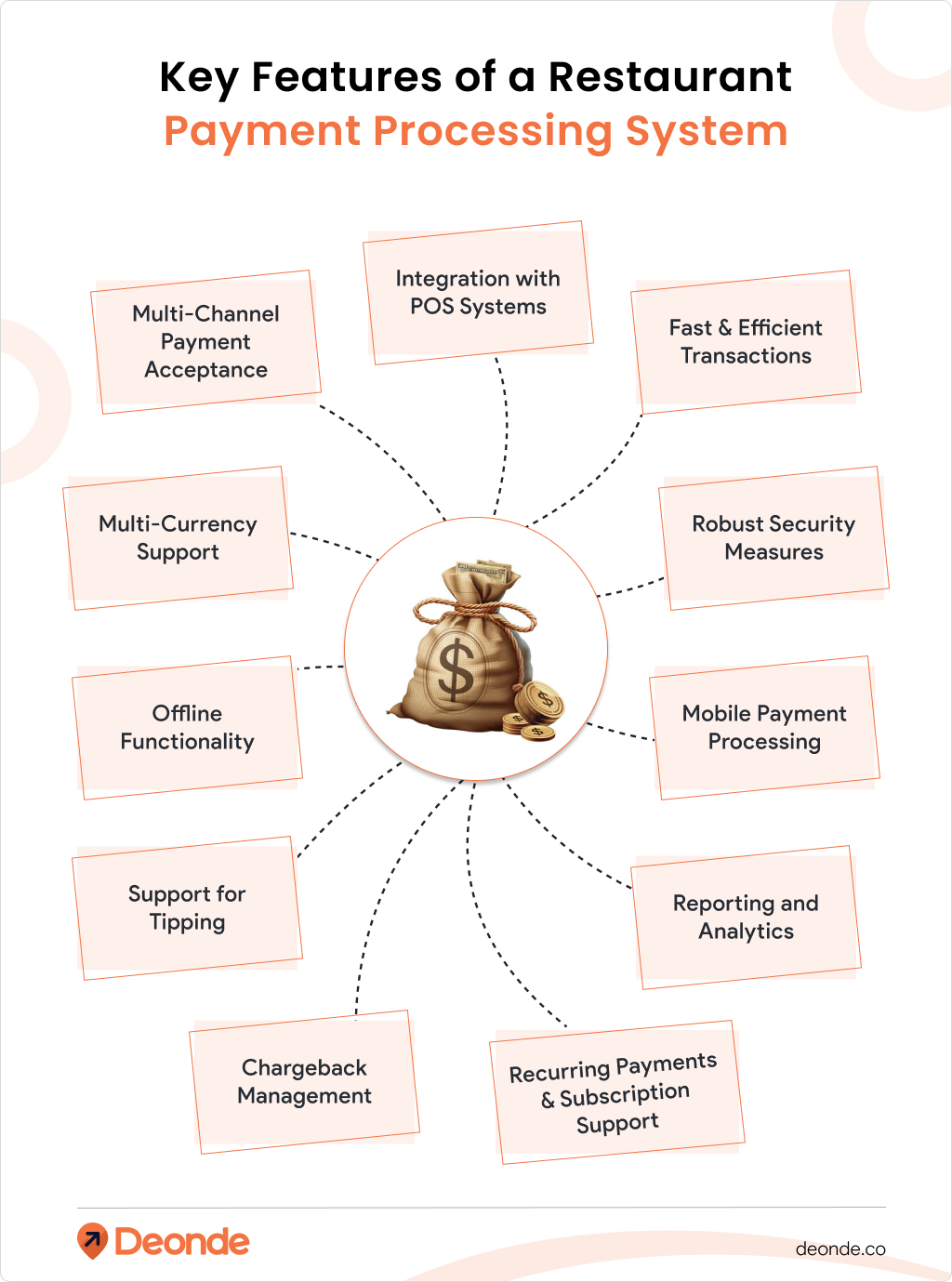
Now that you know the workings of payment processing, let’s look at some basic features you’ll find in a restaurant payment processing system.
A robust restaurant payment processing system should offer a range of features to streamline operations and enhance customer experience.
With that in mind, here are some features you should look out for:
Multi-Channel Payment Acceptance:
Equip your restaurant to handle multiple payment methods. This includes traditional options like cash and credit/debit cards, as well as modern digital wallets (Apple Pay, Google Pay) and contactless payments. This ensures the delivery of a better customer experience, thus improving the profitability of the business.
Integration with POS Systems:
The restaurant payment processing system seamlessly integrates with your existing POS setup, creating a well-synchronized operational system. This connection ensures data flows smoothly between the two platforms, automating sales tracking, inventory updates, and reporting. A tight integration minimizes manual data entry and reduces the risk of errors.
Fast & Efficient Transactions:
This feature ensures a swift payment completion process, thus reducing wait times at checkout. Additionally, it helps improve table turnover, customer satisfaction, and the operational flow of your restaurant.
Robust Security Measures:
Protecting sensitive customer and business data is important for building a brand that customers trust. Look for payment processing systems that are PCI DSS compliant and employ advanced security measures like encryption and tokenization to prevent fraud and data breaches.
Mobile Payment Processing:
Enable customers to pay using their smartphones or tablets. Mobile payments offer a convenient, contactless payment option that many diners increasingly prefer.
Reporting and Analytics:
Gain valuable insights into your business with detailed reports on sales trends, customer behavior, and peak hours. These restaurant analytics empower you to make data-driven decisions about menu planning, staffing, and marketing strategies.
Recurring Payments and Subscription Support:
It helps simplify billing cycles for restaurants offering subscription-based services or exclusive membership programs. This aids in customer retention and the generation of consistent revenue streams.
Chargeback Management:
A good system should provide tools to manage chargebacks effectively. This includes the ability to provide evidence, such as order receipts and delivery confirmations, to dispute unwarranted claims and protect revenue.
Support for Tipping:
This incorporates flexible tipping options into the payment process, thus providing smooth transactions and fair staff compensation.
Offline Functionality:
This feature ensures your payment system remains operational even during internet outages. Furthermore, it seamlessly syncs the data once the connection is restored.
Multi-Currency Support:
Multi-currency support is essential if your restaurant caters to tourists or international customers. This allows you to accept payments in various currencies and enhances the customer experience.
5 Steps to Integrating Payment Processing in Your Operations
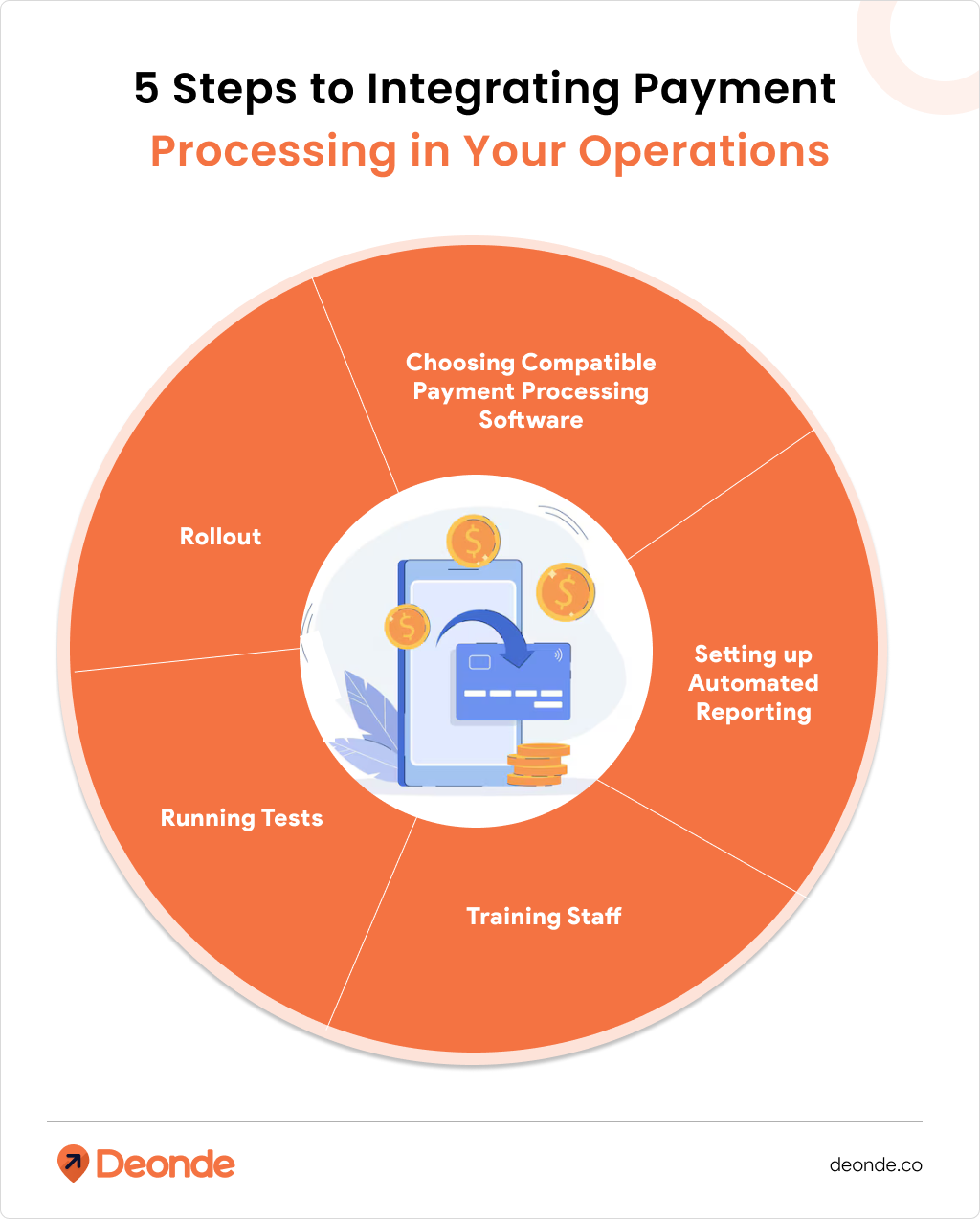
How to integrate a modern payment processing system into your workflow? Let’s find out:
Step 1: Choosing Compatible Payment Processing Software:
Opt for a payment processor adaptable to your existing POS for seamless data sharing across platforms. When you choose Deonde, you choose a system that seamlessly integrates your specific POS.
Deonde’s online payment system is designed to connect with your POS, website, and other platforms.
This compatibility is crucial for a unified view of your business. For example, online orders processed through Deonde’s system should automatically update your inventory in your POS.
Step 2: Setting up Automated Reporting:
Once your POS is connected to Deonde, you’ll find reports and analytics highlighting your sales summaries and transaction details. Deonde also generates automated reports that feed directly into your accounting software, minimizing manual data entry and the risk of errors.
Step 3: Training Staff:
Invest in thoroughly training your staff to ensure they become well-versed in using the payment processing system. Your restaurant staff needs to know how to process payments using Deonde’s system—both in person and online.
They should also be able to handle refunds, troubleshoot basic issues, and understand the reporting features.
For online orders, staff needs to know how to manage incoming orders, update order status, and communicate with customers.
Step 4: Running Tests:
Conduct a pilot test of the new system before rolling it out to identify any integration issues and prevent unwanted operational disruptions. This testing phase is critical to identify and fix any glitches before they impact your customers and operations.
Rollout:
Even after testing, monitor the payment processing system closely during the initial days of live operation. Check for any discrepancies in transactions.
Be prepared to address any staff questions or concerns and have Deonde’s support contact information readily available in case of issues.
Step 5: Restaurant Payment Processing Rates
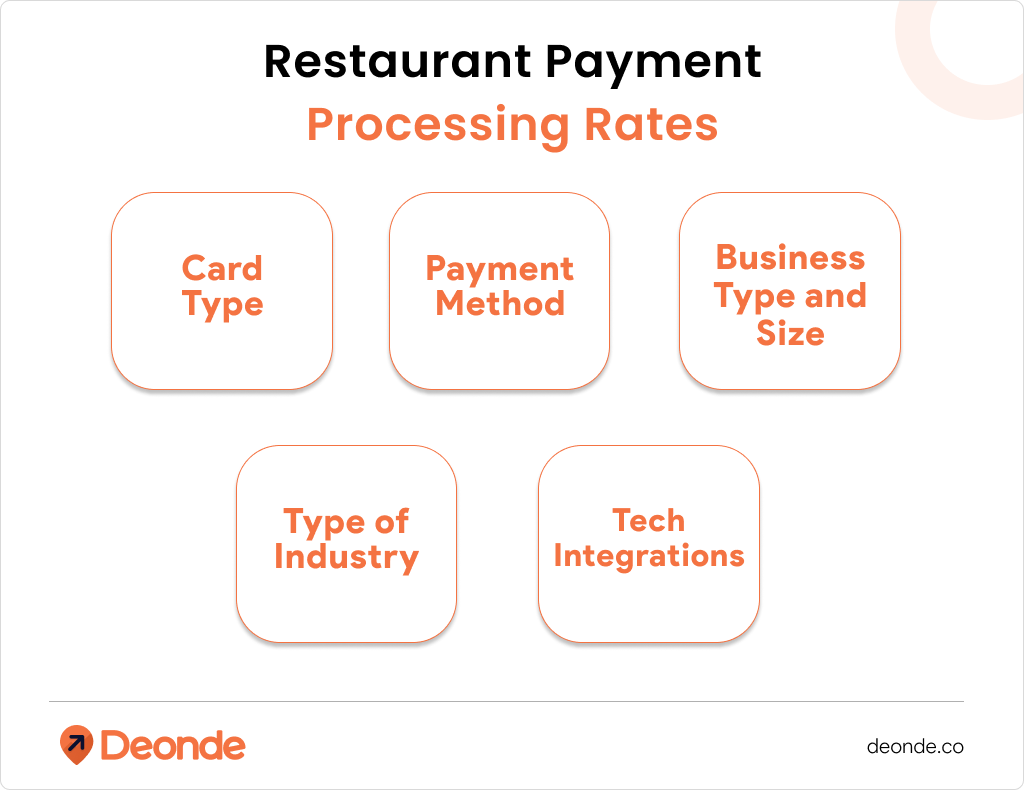
Restaurant payment processing rates are influenced by several factors, as listed below:
Card Type
Premium cards, such as rewards or international business cards, and certain card brands (like American Express) typically have higher processing fees due to their added benefits.
Payment Method
The way a transaction is processed impacts the cost.
More secure methods, like EMV chip cards (dip and PIN) and contactless payments (tap or digital wallets), generally have lower fees due to reduced fraud risk.
Less secure methods, like manual entry or traditional swiping, often incur higher fees.
Business Type and Size
Larger businesses with higher transaction volumes often have more negotiating power and can secure lower processing rates. Smaller businesses may face higher rates due to lower volumes.
Type of Industry
Some industries are considered higher risk than others due to factors like fraud potential or chargeback rates. Restaurants, while generally not considered high-risk, can still have variations based on factors like average transaction size and order volume.
Tech Integrations
POS systems with integrated payment processing often offer streamlined setup and potentially lower fees—as they may have negotiated rates with their preferred processors.
However, you might have less flexibility to choose a processor that best suits your needs.
Hence, understanding the factors influencing processing rates is essential for restaurants to choose the most cost-effective payment processing solution. If you’re still unsure how to choose and set up a modern payment processing system for your restaurant.
Conclusion
As a restaurant owner, adopting a new payment processing system can feel overwhelming.
Furthermore, the consequences of choosing an incompatible or inefficient system can lead to operational disruptions, increased costs, and customer dissatisfaction.
With Deonde’s online ordering suite, you can not only increase profits but also enhance customer satisfaction through efficient payment processing.
Give your customers the modern dining experience they expect—only with Deonde.
Deonde’s seamless online ordering and payment system supports over 30 payment gateways, including digital wallets and contactless options, making it easier than ever for customers to order and pay.
Enhance customer satisfaction, boost loyalty, and drive repeat business. Explore our customer-centric features and get started with Deonde today!
FAQs
1. What is Restaurant Payment Processing?
Restaurant payment processing enables restaurants to accept electronic payments from customers. It involves securely transferring funds from the customer’s payment method (card, digital wallet) to the restaurant’s bank account, utilizing various players, like banks, processors, and payment gateways. It’s essential for modern commerce and on-demand food delivery.
2. What is a Payment Gateway?
A payment gateway is a secure online portal that transmits payment information between the restaurant and the payment processor. It encrypts sensitive data and ensures secure online transactions.
3. What is the difference between a Payment Gateway and a Payment Processor?
A payment gateway is a technology that acts like a secure tunnel, connecting the merchant to the payment processor. The payment processor, on the other hand, is the entity that handles the transaction, including authorization and settlement.
4. How do Restaurants Integrate Payment Processing with their Online Ordering Systems?
Restaurants can integrate payment processing with online ordering systems through a payment gateway. The gateway is integrated into the online ordering platform, allowing customers to enter their payment information. This integration allows restaurants to accept online payments, enhancing customer convenience and streamlining operations.
Choosing the right payment gateway and ensuring a secure integration is crucial for the success of online ordering.

